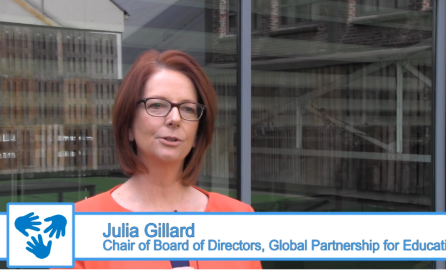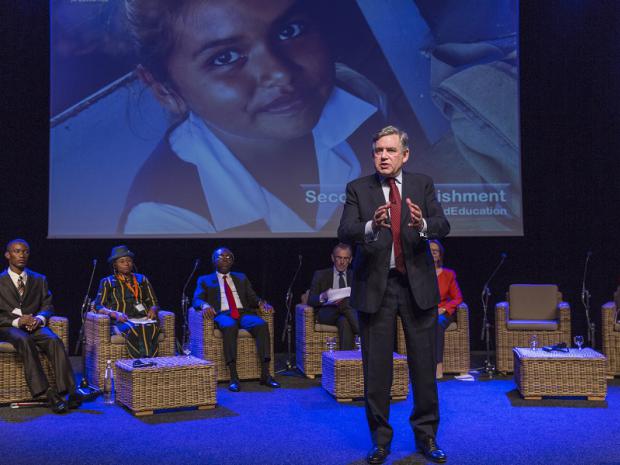Global aid to education is dropping. After rising steadily in the first decade of the 21st century, aid to education fell by 10 per cent between 2010 and 2012. Yet almost 58 million children remain out of school, with girls particularly affected. The Millennium Development Goal of giving every child basic literacy and numeracy skills by 2015 will not be met.
Enter the Global Partnership for Education (GPE), an organisation founded in 2002 that unites the main education stakeholders (donor countries, private foundations, civil society, teachers, the private sector and 59 partner developing countries) around the goals of improving access, equity and quality, as well as data and education management systems.
The European Union has been supporting the initiative since its foundation to raise the profile of education, mobilise funding and promote the aid effectiveness principles it is founded on: country level focus, the use of existing structures, and government leadership.
GPE’s Second Replenishment Conference was hosted by the EU in Brussels in June with 800 delegates, including 40 government ministers, meeting to raise funds for education from donors as well as in the national budgets of developing partner countries. The aim is to mobilise US$3.5 billion for the GPE Fund during the current funding period between 2015 and 2018.
On the final day, GPE announced 27 developing partner countries had committed to increase their domestic spending on education by an unprecedented US$26 billion, well above GPE’s initial target of US$16 billion. Fifteen donors also pledged US$2.1 billion, including a first ever pledge to the Fund from a private foundation.
European Development Commissioner (and former teacher) Andris Piebalgs said:
“I am delighted to see all of the pledges being made here today, in particular those by our developing country partners, which will help to make a difference to the lives, and the futures, of millions of children across the world.”
The Islamic Development Bank pledged US$400 million accessible via a ‘loan buy-down’, whereby borrowers are released from some or all future repayments provided they meet performance targets. This is the first time this mechanism has been used in the education sector, and more information from GPE is available here.
GPE’s funding model is changing too. Whereas partner governments once received all funding upfront, access to 30 per cent of donor funds will now be linked to countries achieving results in key areas.
“We need to sharpen our focus on results,” said Julia Gillard, the former Australian prime minister and chair of GPE’s board of directors. “What is happening in GPE is really a subset of the broader global debate that in education counting access statistics is important – we’ve got 57 million kids still out of school, many of them girls, so we’ve still got to be counting access – but as we do that we increasingly want to also monitor quality of learning. So are kids sitting in school and actually learning?”
In order to access 70 per cent of all available funds governments must reach the following performance benchmarks:
- prepare a credible and costed education sector plan,
- commit to do an education sector analysis and collect education data,
- commit to raising education spending to at least 20 per cent of the national budget.
Countries are eligible to an additional 30 per cent of GPE funding if they demonstrate significant performance results in three areas:
- equity,
- efficiency,
- learning outcomes.
In its own literature GPE says “it is realistic about achieving uniform progress among fragile and conflict-affected states”. For these most vulnerable states, the funding model may reward “intermediary milestones”, such as evidence of countries having adopted stronger policies. Forty per cent of GPE’s work currently is in fragile or conflict-affected areas.
One organisation with experience in implementing results-based education programmes is the U.S. Agency for International Development (USAID).
USAID Assistant Administrator Eric Postel, who also attended the Brussels conference, said he has seen little resistance to the assumption that money from American tax payers should be spent judiciously, and many education ministers have embraced the chance to showcase good results.
“Just at lunch the Minister [of Education] of Liberia was talking about how there were literally hundreds of people on their payroll who had no educational role in their ministry. They weren’t working, they were collecting money. By working through all of that, in eliminating all those, they were able to reduce the number of people in the headquarters and redeploy all that money to educating children.”
“There is one outlier case of where GPE provided money to a government and then, I don’t know all the reasons but that same year the government cut their own funding to education by almost a similar amount. We are not there to substitute for the host country government, we are there to work with them to do something bigger and better.”
On average however, data from GPE’s 2013 Results for Learning Report showed domestic financing for education as a share of the gross domestic products (GDP) in GPE partner developing countries increased by 10 per cent after they joined the partnership.
Gordon Brown addresses the GPE Replenishment Conference in Brussels. Image: GPE/Mark Hens
As the development community debates what should replace the MDGs after 2015, UNESCO has argued for explicit targets for education spending. In its recent Education for All Global Monitoring Report 2013-2014 it advocated countries spend at least 20 per cent of their budget, or 6 per cent of GDP, on education.
Ms Gillard said GPE was still discussing its priorities for the post-2015 agenda but that she supported targets for Domestic Revenue Mobilisation.
“Whether it is a percentage of GDP or a percentage of government expenditure, it is all trying to get to the same outcome, which is more financing being mobilised by developing country partners from their own domestic resources.”
At a practical level, delegates heard one of the greatest obstacles to education is often the competing demands on children to work in order to provide for their family. GPE targets primary school children, whom it says should never work.
Meanwhile, when it comes to older children, Mr Postel described USAID projects that allowed adolescents to earn some money outside of school, without the need to skip class.
In a slum in the Dominican Republic for instance, adolescents were taught sewing, hairdressing and manicuring skills as well as how to mix chemicals into household cleaning products.
“These young adults were then able to sell those to neighbours and friends, and create incomes of $20, $40 [or] $100 dollars a month. That money could come back into the family and then the parents weren’t faced with that choice of sending the kid to school or have them working or helping.”
In Bangladesh, the head of human and social development in the EU Delegation, Libuše Soukupová, said parents could not afford to have their children stop work entirely, given they may provide up to 40 per cent of household income. As a result, non-governmental organisations (NGOs) have gone into slums that are beyond the reach of government services, to establish schools and lobby factory-owners to let adolescent employees go to class.
“It’s not only setting up the schools in the slum it’s also, first of all, getting to the employers and telling them ‘well, why don’t you send the children to school? They should not be here from 8am to 8pm. And often they are not working because for example there is a power cut, so let them out...’”
Ms Soukupová said employers were increasingly supportive of the idea, albeit for self-serving reasons.
“We always ask the employers why they do it and they say, ‘we appreciate when the kids go to school because they are happier. They are more efficient’.”
“The employers know that [child labour] is illegal, so the first time [NGOs] would not be let in. They kept going, they gained the trust. So now there is a trust between the projects and the employers. I think this is an area where the EU has experience, where we have added-value, and this is a place I think we should continue working.”
Discussion in Brussels also focused on what children learn once in the classroom. One trend in education theory has been the need for a shift away from rote learning, towards so-called ‘soft skills’. Stephan Turnipseed, executive director of strategic partnerships for LEGO Education, told delegates that 65 per cent of the jobs required in the near future are yet to be defined. Given this, he argued memorising content was not enough, and creativity, collaboration and communication skills were vital.
One initiative on display in Brussels was “6 Bricks” – a plan to send six different coloured DUPLO bricks (twice as big as a standard LEGO brick) to classrooms around the world as an aid for teaching pre-numeracy and pre-literacy skills.
LEGO education agent Brent Hutcheson explained the average range of vision of a child is four DUPLO bricks.
“You need to build outside of that range of vision if you want to develop problem-solving or lateral thinking skills. But it’s also important for reading because it means their eyes have to move from inside a range that they can see to outside that range.”
One pack of six bricks costs five dollars, and these are intended to be used over five years of schooling in games and activities that build inhibitory control, working memory, and cognitive flexibility.
6 Bricks is already in use in Ukraine, Mexico, Denmark, South Africa and Turkey and the philanthropic LEGO Foundation will consider financial support to other countries that cannot afford to buy the bricks themselves. More information on 6 Bricks is available here, and a video of Brent Hutcheson explaining the initiative is on our Public Group on Education and Development.
|
EU Contribution At the GPE Replenishment Conference, European Development Commissioner Andris Piebalgs announced an additional €375 million (US$510 million) to contribute to supporting basic education in nearly 60 countries where the Global Partnership for Education currently works. Total EU funding for education in developing countries is expected to total some €4.5 billion between 2014 and 2020. This includes €2.8 billion for basic and vocational education, the bulk of it through bilateral cooperation, and €1.68 billion to the higher education programme. 51 per cent of the countries supported are ‘fragile’ (countries currently affected by conflict and post-conflict countries) – an increase of almost 10 per cent up from the previous programming period of 2007 - 2013. For more information see the press release and previous EU commitments to the Partnership. |
|
For more information: The full video interviews with Libuše Soukupová and Eric Postel are available on our Public Group on Education and Development. |
This collaborative piece was drafted with input from GPE, USAID, and Libuše Soukupová, Marja Karjalainen and Graca Sousa from EuropeAid, with support from the capacity4dev.eu Coordination Team. Teaser image courtesy of GPE / Jawad Jalali.




Log in with your EU Login account to post or comment on the platform.